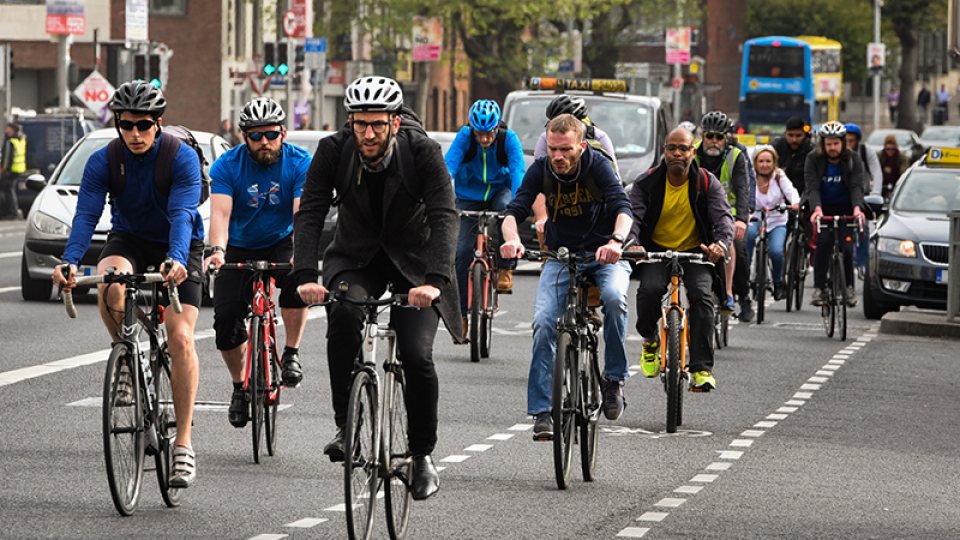Improved Design Emerges for Fairview Cycle Route
Dublin City Council has amended the cycle route’s design in accordance with the project’s planning conditions.
The Clontarf-to-City-Centre Cycle Route, which will run through Fairview, North Strand, and Amiens Street, went through a fairly contentious planning process last year with various campaigns and objections related to the loss of mature trees, the interaction of cyclists and buses at bus stops, and the loss of a general traffic lane in Fairview.
In the end, the project received Part 8 planning approval in a Council vote in October 2017, but with three major conditions attached relating to the detailed design of the cycling infrastructure:
The locations of bus stops shall be examined and all bus stops along the route shall be redesigned to segregate buses and bicycles as recommended by the National Cycle Manual.
The junctions and traffic signalling on the route shall be designed a) to provide for pedestrians in line with the Design Manual For Urban Roads and Streets and b) to provide for full segregation of bicycles and motor vehicles.
The widths of cycle facilities and buffers are to be in line with the specifications in the National Cycle Manual. If there are pinch points where this is not possible, such locations are to be subject to special design consideration and a safety audit.
Dublin Cycling Campaign lobbied intensively for these three conditions to be adopted, as the previous design would have led to cyclists interacting with buses at most of the bus stops along the route. The previous design also offered no protection for cyclists at major junctions, which include notoriously hostile intersections at Portland Row, Malahide Road, and Howth Road. Dublin Cycling Campaign was also concerned that best practice design guidelines for pedestrian walkways and the public realm were being ignored along the route, hence the reference to the Design Manual for Urban Roads and Streets (DMURS).
Fast forward six months, and last week Dublin City Council invited stakeholders to view the revised design for the cycle route at a meeting in Fairview. The meeting was attended by local area representatives, members of the local business community, members of local residents groups, and Dublin Cycling Campaign. Dublin City Council engineers presented the updated design, which was draughted by external engineering consultants Roughan O’Donovan and AECOM, and fielded questions from stakeholders.
Dublin Cycling Campaign is extremely satisfied with the revised design of the project. Along with the excellent cycle route, we are also delighted to see improved pedestrian facilities and proposed upgrades to the public realm along the entire route.
The revised design will see cyclists completely segregated from motor traffic with a one-way, kerb-protected, two-metre wide cycle track on each side of the road. The design also keeps cyclists and buses apart at bus stops with the use of bus stop islands, also known as bus stop bypasses. The updated design also provides for segregation of cyclists at the major junctions, in a manner familiar to those who have cycled in Dutch cities, but something that will be a novelty in Dublin.
Pedestrians will benefit greatly from the revised design too. There will be new pedestrian crossings along the route, especially in Fairview where there are currently long stretches without any means of crossing the road on foot. The junctions at minor roads will also be redesigned to give continuity to cycle tracks and pavements, reminding drivers going into or out of the minor streets to yield right of way to pedestrians and cyclists. The bus stop islands will also make life easier for pedestrians, meaning they won’t have to navigate through crowds of people blocking the footpath at bus stops.
The spacing and positioning of bus stops has also been rationalised along the route which should lead to a faster, more efficient, and more reliable bus service for people traveling into and out of the city.
A major aspect of the revised design involves improvements to the public realm along the route. This will be most obvious in Fairview where new public space will be created outside its cafés, bars and shops. Fairview Park will also receive a new “esplanade” (a wide, shared pathway for walking and cycling) along its perimeter with the main road which, along with the increased number of pedestrian crossings, should reinforce the park’s connection with Fairview village and enhance it as an amenity for locals and passers-by alike. Overall, the revised design will make Fairview a more attractive place to live, work, shop, and study in - and not just a place to be passed through on the way into or out of town.
Finally, the revised design allows for the beautiful mature trees along the perimeter of Fairview Park to be retained, and opens up the possibility for new tree planting along the route.
Dublin Cycling Campaign commends Dublin City Council and its consultants for listening to the concerns of stakeholders and for the exemplary design they have brought forward. We believe it matches up to cycling design standards seen in pioneering countries such Denmark and the Netherlands. There are some minor issues at junctions and buffer zones which Council officials are looking at and on which we will continue to work with them. This project, if completed in line with the developing design, could act as a template for major routes in Ireland’s urban areas, including the routes being developed in the Bus Connects project in Dublin, Cork and Galway.
Regarding the timeline for the project, it is expected that further consultation, site investigations, detailed design, and tendering could take between six and twelve months. The construction phase of the project could then take up to two years to complete. Dublin Cycling Campaign will keep you informed on any further updates on this project, and you can also follow the project on Twitter using the hashtag #FairviewCycleRoute.
Help us do more for cycling in Dublin by becoming a member!

